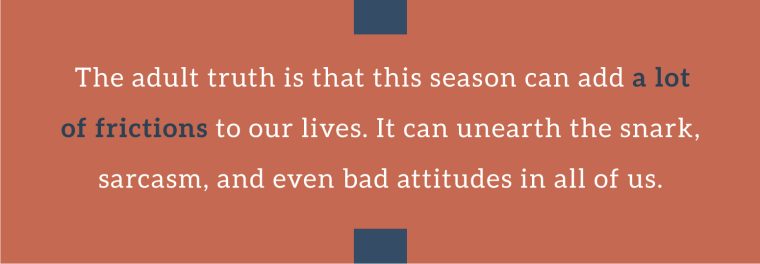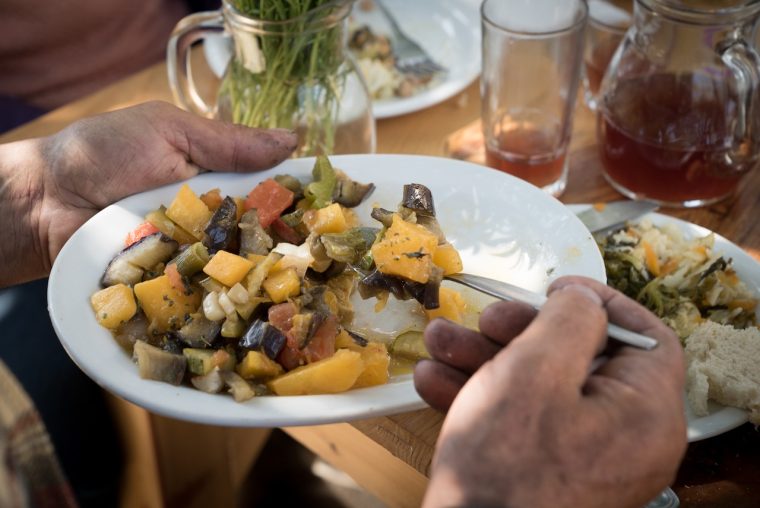As you’re probably aware, this can be a very salty season, and in multiple different senses of the term.
Most obviously, there are lots of delicious salty treats making the holiday rounds (and hey, all things in moderation). There’s also a different smell to the air—sharp, biting, sometimes smoky—and of course, when the temperature of the air drops far enough, we literally salt the roads.
But this season is also “salty” in the sense that, well, it can be tiresome and cranky for anyone. We idealize the holidays and their happy memories, and we hope to make more, but…

So today’s two main articles are about the salt of the season, both literal and figurative. First, we’ll take a look at the most important item in your spice cabinet, salt (and its sidekick in the Western world, pepper). Then we’ll segue—somehow—to a practical perspective on the “expenses” of maintaining a good attitude. Spoiler alert: it’s actually cheaper than it seems, especially when you consider the alternatives!

In Edition 30, we took a look at the nutritional and culinary value of herbs and spices.
To follow that up, I want to focus today on two of the most important seasonings in the world: salt and pepper. Why are they so ubiquitous in cooking, and how did they wind up on most of the dinner tables in the Western world?
Salt and pepper do, of course, pair well together; in other words, they complement one another. Having said that, they play very different roles in both nutrition and flavor, so I’ll discuss them separately and bring things back together at the end.
Now then! Let’s start with salt, which is (quite frankly) the more important member of its duo.
Salt is one of the most important commodities in human history, to the point that it has also served as a currency on many occasions. That’s where we get the word salary (which originally denoted a Roman soldier’s allowance for buying salt) and expressions like “worth its salt.”
Salt is cheap and plentiful to most people nowadays, but that wasn’t always the case—and no matter its market price at any given time and place, here are four reasons that people have always wanted salt:
1️⃣ Our bodies need it. We can overdo it on sodium, of course, but that doesn’t change the simple fact that our bodies use salt in a wide variety of ways. We crave salt for the same essential reason we crave sugar: we need it!
Modern-Day Note: Try to use at least one kind of salt with iodine. A lot of people have deficiencies and that’s a good way to ensure you’re getting some.
2️⃣ It’s a natural preservative. Electric refrigeration is a miraculous invention, but in the grand scheme of human history, it’s extremely recent. For all of the countless years before fridges and freezers, salt was one of the only reliable ways people knew to keep foodstuffs like meat from spoiling. Without salt, a lot of people were destined for hungry winters or (in sailors’ cases) short voyages.
3️⃣ Its chemical properties are useful in and out of the house. Take, for example, the fact that salt lowers both the boiling point and freezing point of water. The former is useful in the kitchen (for boiling water sooner and/or harder), and the latter is useful on roads and sidewalks (for helping melt snow and ice).
And then there’s the fourth reason we like salt, and it’s the reason that transforms salt from merely “useful” to “special and desirable”:
4️⃣ Salt is a flavor enhancer. It’s important to emphasize the word enhancer, because this is what sets salt apart from everything else in your spice cabinet.
With most other seasonings, you are adding flavors; in other words, you’re making the food taste more like the things you’re mixing into it. Salt is different because (unless you really overdo it) it doesn’t make food taste more like salt; it makes food taste more like itself.
Salt gets top billing in the title of Samin Nosrat’s seminal cookbook Salt Fat Acid Heat because it’s one of the primordial elements of cooking—and arguably the most important for flavor, thanks to its unique ability to enhance whatever flavors are already present. Salt can even enhance the flavors of sweets like chocolate!
Last but not least, salt also enhances flavors indirectly. For example, salting ingredients before cooking them tends to pull water and soluble proteins closer to the surface, which makes the Maillard reaction (of crispy, golden-brown fame) easier and more effective.
Now let’s take a closer look at pepper, which (again) is frankly the less important of the two.
Pepper is less important, first of all, in the sense that it’s more variable. Salt is found and used all over the world, but pepper is only native to a few places, like Malabar in India. True, pepper is one of the most widely-traded commodities in world history, and there are reasons it became a staple of the Western dinner table (more on that at the end)—but it’ll never be as ubiquitous as salt and, per the above section, it’ll never have salt’s flavor-enhancing power.
Pepper is also less important than salt in the sense that it’s not an essential nutrient. Don’t get me wrong, pepper is definitely good for you—it’s a source of antioxidants and it potentiates other helpful substances like curcumin, among other benefits—but the body doesn’t suffer without pepper like it suffers without salt.
Having clarified that, here are three big reasons for pepper’s enduring popularity:
1️⃣ Historically, pepper complemented salt in the preservation of food. This is because, while salt is particularly good at keeping foods like meats from spoiling, pepper is particularly good at concealing whatever spoilage happens anyway. That’s a little icky to think about now, but in ye olden days, it was a major perk of being able to afford imported peppercorns.
2️⃣ Pepper’s flavor is well-balanced and widely appealing. It plays well with other seasonings, it adds some zing without making food overtly spicy, and it generally makes food more interesting (particularly to an old-timey, pre-globalized palette).
Modern science helps to explain the appeal of pepper in more detail. We now know, for instance, that ?️ the compounds that give pepper its flavor are highly soluble, so you can taste them in pretty much any sort of food, and ?️ pepper stimulates our salivary glands in ways that most other spices don’t.
As for pepper being found on most Western dinner tables…
3️⃣ Blame Louis XIV for the rest. If you’re not a history person, just know that Louis XIV was kind of a big deal (and he’d have said so, too). He ruled France for most of the 17th century, during one of its most prosperous eras, and he’s responsible for a lot of the opulence we associate with European monarchy; for instance, he commissioned the Palace of Versailles.
Ironically, though, the Sun King was, in the most literal way, a man of simple taste: he preferred the straightforward contributions of salt and pepper over the litany of spices and seasonings that had become commonplace in the royal court. Thus, he is often credited with popularizing salt and pepper on the table—and it makes more sense that this could trickle all the way down to the present when you remember that France is the birthplace of “high cuisine” and the modern culinary arts.

Also in Edition 30, I began a quick three-part series on the importance of good attitude.
My point in Part 1 was relatively simple: you tend to see nothing but good attitudes among the world’s centenarians, and that’s not a coincidence. Whatever you want to call it, there’s something about a bad attitude that reliably kills its owners well before the 100-year mark. ?
For the remainder of this series, I face a bigger challenge: convincing you that there’s anything new and worthwhile to say about attitude. It’s one thing to do what I did in Part 1 and scientifically validate what most of us already knew; it’s quite another thing to try and share fresh advice without sounding flowery or pedantic.
If we roll our eyes at the mention of “good attitude,” I think it’s because the term has increasingly been used in normative ways. In other words, “good attitude” is something that we’re expected to maintain in more and more situations, no matter how much it taxes us and no matter how hollow or disingenuous it may feel. We’re bound to feel a little twisted up inside if we think of “good attitude” as an obligation that we primarily owe to others and not ourselves, and we’re bound to wonder what we really get for those mental efforts.
But there’s a practical way to untangle this. Once we do a little bit of “accounting,” it’s easier to see that maintaining a positive attitude only seems “expensive” when we fail to consider where those mental resources come from or, more importantly, where else those resources are going.
So here are my two pieces of advice, both aimed at helping you reserve enough energy for the genuine good attitudes that can pay dividends directly to you:
1️⃣ Be mindful of empathy fatigue. We think of empathy as though it comes from the bottomless reaches of our soul when, in practical reality, it’s just another one of the batteries in our brain that can run out of juice.
As kids nowadays might succinctly explain it, empathy fatigue is the idea that people can, in fact, run out of f***s to give. When that happens, we become considerably less pleasant versions of ourselves, and we make messes that require all the more effort to clean up.
The term empathy fatigue has only come into vogue recently, late in the Internet Age, but there’s your explanation: never before, in all of human history, have we been expected to care about nearly so many things at once. It’s probably a good thing that empathy comes naturally to us—that whatever we care about, we care automatically—but it also means that we can deplete our energies without making a conscious decision to do so (or even realizing that it’s happening).
I think often of this selection from Andrew Boyd:
“Compassion hurts. When you feel connected to everything, you also feel responsible for everything. And you cannot turn away. Your destiny is bound with the destinies of others. You must either learn to carry the Universe or be crushed by it. You must grow strong enough to love the world, yet empty enough to sit down at the same table with its worst horrors.”
There’s a lot more we could discuss here, but the essential point is that we have to manage our exposure to the rest of the world if we’re going to keep ourselves healthy and sane and if we want to reserve some energy for keeping things positive in the innermost circles of our lives.
That doesn’t mean that we should swing all the way in the opposite direction—from connectedness towards self-isolation—but we do have to find a sustainable balance between them. If nothing else, that probably means finding ways to keep our doom-scrolling and news-watching down to reasonable levels.
2️⃣ Remember that “mad is sad’s mask.” Human emotions are complicated, and I don’t want to oversimplify things too much—but the trick here is to notice that certain emotions link together. We rarely ever feel just ONE way when we feel strongly about something.
As different as they may seem, anger and sadness are often linked in this way. A lot of everyday anger can be explained as a “sideways” expression of sadness because, while anger isn’t a fun feeling, it feels way safer than vulnerability to most people, most of the time. Hence the expression mad is sad’s mask. ?
I bring this up because emotions—but especially anger—burn a lot of the same essential energy I mentioned above, and doubly so when that anger is misplaced or misdirected. We can save ourselves a lot of heartache, individually and collectively, if we try to remove that “mask” and confront our true feelings where they stand. This is one of the times in life when we want to fight fire with water, not more fire.
To illustrate and wrap things up, let’s briefly revisit a classic pop-culture reference…
Howard Beale’s famous outburst from the movie Network (“I’m as mad as hell and I’m not going to take this anymore!”) seems to capture the zeitgeist of the 2020s as well as it did the zeitgeist of its native 1976. But if you listen to his monologue again, you’ll see that all of the sadness has been left in plain sight.
An abridged selection to prove my point:
“I don’t have to tell you things are bad. Everybody knows things are bad. It’s a depression. Everybody’s out of work or scared of losing their job. The dollar buys a nickel’s worth; banks are going bust; shopkeepers keep a gun under the counter; punks are running wild in the street, and there’s nobody anywhere who seems to know what to do, and there’s no end to it.
“We know the air is unfit to breathe and our food is unfit to eat. And we sit watching our TVs while some local newscaster tells us that today we had fifteen homicides and sixty-three violent crimes, as if that’s the way it’s supposed to be!
“It’s like everything everywhere is going crazy, so we don’t go out any more. We sit in the house, and slowly the world we’re living in is getting smaller, and all we say is, ‘Please, at least leave us alone in our living rooms. Let me have my toaster and my TV and my steel-belted radials, and I won’t say anything. Just leave us alone.’”
And so I will… as soon as I’ve shared this edition’s recipe. ?

Winter Potato Salad
Ingredients
- 8 cups water
- 2 pounds potatoes, peeled and cut into quarters or eighths, depending on their size (waxy potatoes like Yukon gold or red potatoes work best)
- ½ cup chopped fresh dill
- ½ cup extra-virgin olive oil
- 3 to 5 tablespoons red wine vinegar
- Salt and pepper (optional)
- 2 cups arugula, chopped
- 2 cups spinach, chopped
- 1 large sweet onion (like Vidalia), thinly sliced
- 1 small head green leaf or romaine lettuce, chopped
- 1 small radish, sliced (optional, for garnish)
The Method
- Bring 8 cups of water in saucepan to boil.
- Add potatoes and cook uncovered until tender, about 12 minutes.
- Test by piercing potatoes with a fork—if they pierce easily, they are ready. Drain potatoes and let cool.
- In a small bowl, combine dill, olive oil, and vinegar; season with salt and pepper to taste. Whisk until well combined.
- In a large serving bowl, combine potatoes with dressing and toss well.
- Just before serving, add remaining ingredients through lettuce and toss to combine. Garnish with radish, if using.






